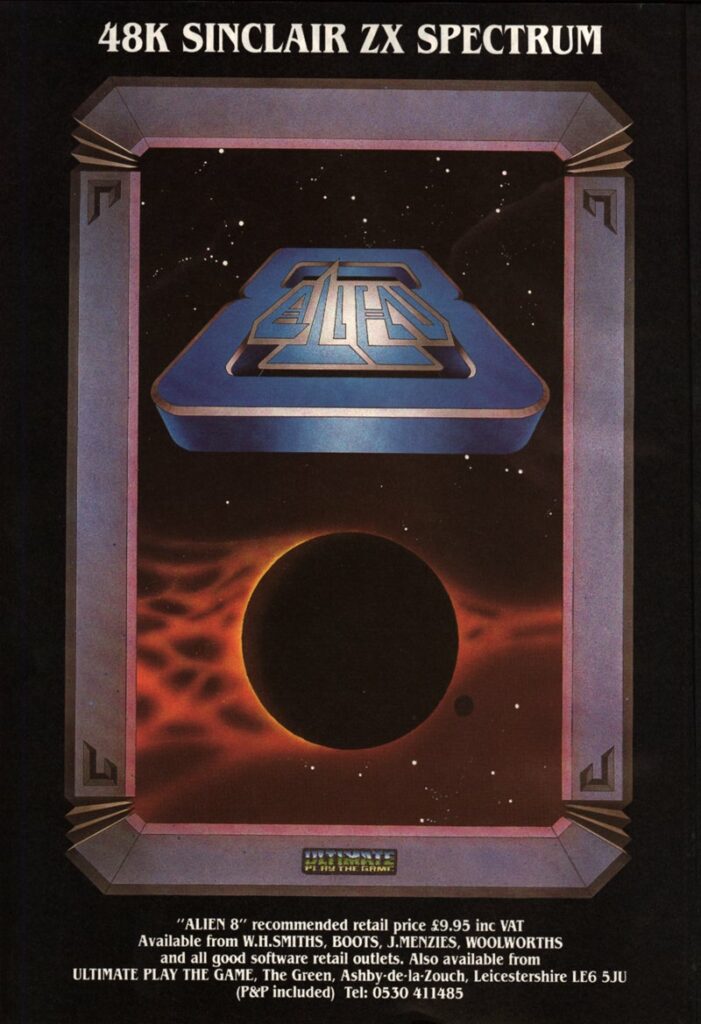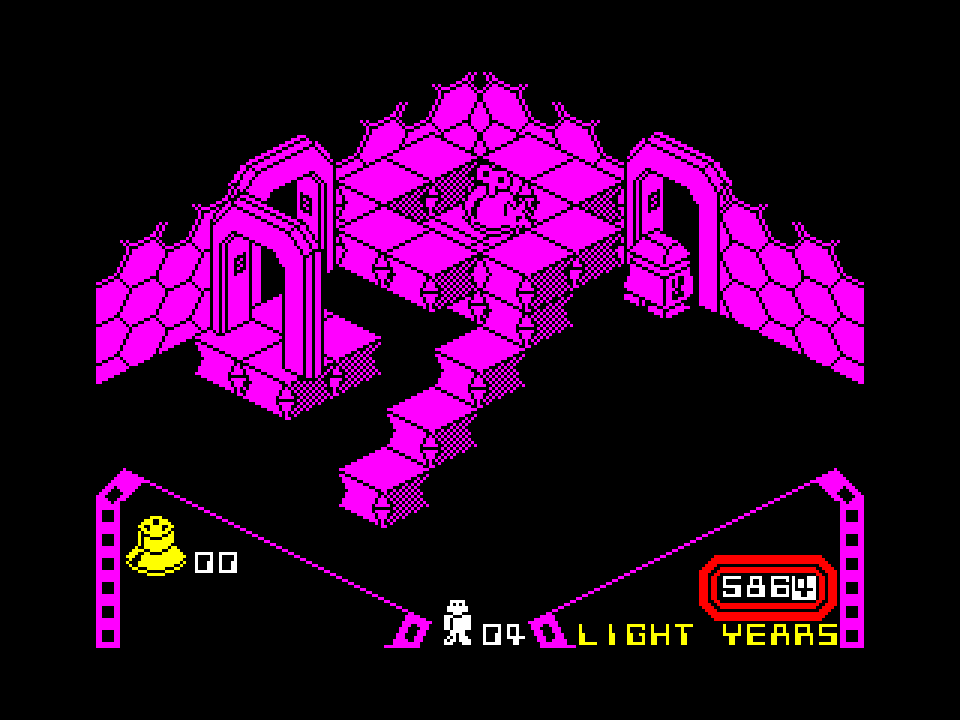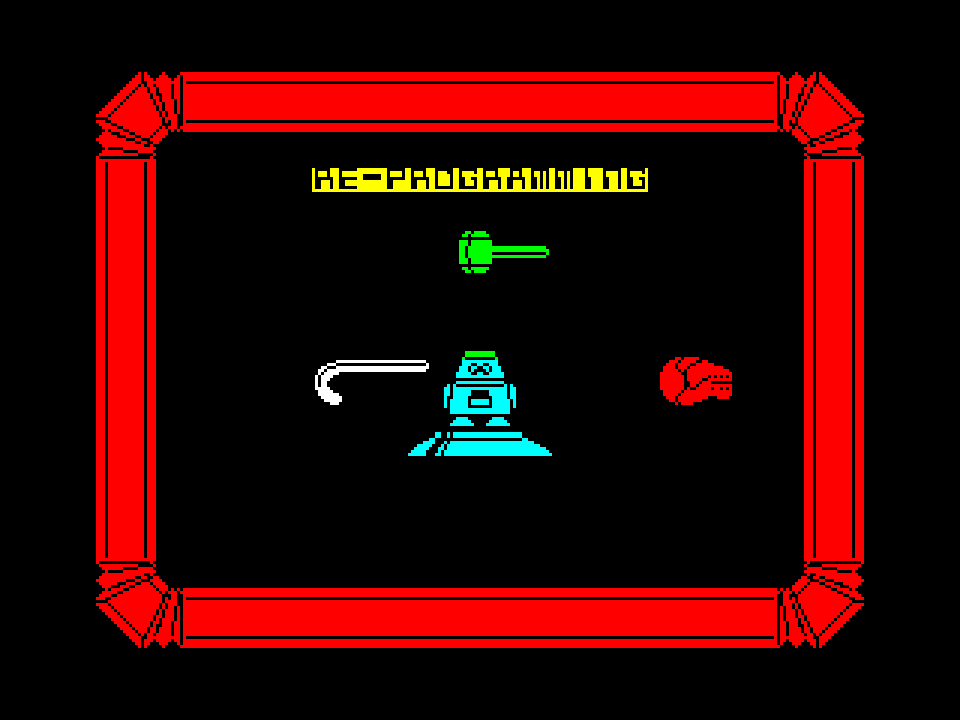Alien 8 Review

Big surprise – An Ultimate Play The Game is mentioned wherever the ZX Spectrum is brought up. But what can and are you supposed to do when the Stamper brothers were the Kings and ground-breakers when it came to creating some of the most iconic games on the platform?
STORY
Alien 8 (And its clever wordplay on “alienate”.) stars a maintenance robot, and the scenario is the final journey of a space-ship on its way to an inhabitable planet – Unlike the one that it left ages ago. All this time, the robot unit known as the “Alien8” has been looking after the ship as it has traveled at hyper-warp speed. Now, the journey is coming to an end at one light year traveled every three real seconds… But the ship is suddenly invaded by malicious aliens who have decided to destroy everything… Not on your shift they bloody won’t…!!!
THE GAME
Ultimate Play The Game’s twelfth release for the ZX Spectrum is their second isometric view flip-screen game after the “video game”-universally acclaimed Knight Lore. Alien 8 has even been described as “Knight Lore set in a space-ship”, but that’s oversimplifying things. The game uses the innovative Filmation engine, which included so many fresh features that it even put many early 80s arcade games to shame. (Except when it came to frame-rate.) This is where the evolution of video games took one big step ahead.
You control the Alien8, and need to prevent total disaster. This is done through “programming” five different tasks: 1) Activate all Cryonaughts. 2) Find a bunch of thermolec valves, and insert them into their right sockets. (There are 33 of these around the ship in four different variations – Pyramid-, cube-, cylinder-, or hemisphere-shaped ones.) 3) Power up the cryo chambers. 4) Make sure the Cryonaughts stay alive. 5) Survive, i.e., find replacement packs for yourself. (You begin the mission with five.)
CONTENT
Alien 8 is approximately 130 screens big. (The map kind of looks like the rough shape of a typical space-ship, but that’s not the most important thing to keep in mind.) And when the game starts, the ship is 600 light years away from its destination. (With an on-screen counter displaying the distance.) One of the first thing you’ll notice is the fact that every new game starts on a different screen. (There are a handful of starting locations – With no “dead ends”, luckily.) Some screens are junctions and work as a link to the more “typical” screens with two or more exits. Usually, there is a platform-related puzzle on these screens, and if you can’t cross them from one direction, there is always a way around. Once you find a socket, it should be matched with the correct valve. (The shape of the sockets change with every game as well.)
Most of Alien 8 is about tricky jumps and avoiding surfaces that are lethal. (Although the various animated Robodroids are just as deadly.) The rest is about finding the valves, trying to remember where “everything” is (Or drawing a map, like we all did back in the days without Internet.), and activating the twenty-four cryo chambers. (And subsequently keeping all 132 Cryonaughts active.)
The Filmation-process includes 50 features – Everything from moving floorways and slides to the more devious trap doors and disappearing corridors. And three-dimensional movement, of course. And that’s the first real challenge – Figuring out where the platforms are exactly in relation to the Alien8. Initially, the isometric perspective might appear confusing. (Like being blinded on one eye and losing the depth perception.) It’s a matter of getting used to it. As it usually is.
The second challenge would be timing the jumps and predicting where the Alien8 lands after a leap. (If you think it’s bad jumping on disintegrating platforms, just wait until you have to float on space-dust!) Prepare to see that amusing “Re-Programming” cut-scene many times after all replacement units (That’s “Lives” in ordinary video game language.) are lost. Even if your patience will be thoroughly tested, you should make some progress – Eventually. Alien 8 rates your performance (From “Poor” to “Adventurer”.) after the game is over, and it also summarizing how many cryo chambers you activated and how many Cryonaughts you lost.
And if we don’t count the fact that time is running out quite fast, the final challenge is the:
CONTROLS
Four options to choose from on the title screen: 1. Keyboard, 2. Kempston Joystick, 3. Cursor Joystick, and 4. Interface II. The last option is “Directional Control”. Using these controls, the Alien8 automatically turns in the direction you walk in. Otherwise, you have to manually turn (90 degrees in a circle at a time.) before moving.
The keyboard controls are all right (Even for those precise jumps.), but a Joystick interface is and will always be a Joystick interface.
There is no option for re-defining the keys for keyboard controls.
GRAPHICS
What else than monochromatic glory? The one on-screen color changes from room to room between the characteristically bright ones – Magenta, cyan, green, and yellow. And with Knight Lore and Alien 8, Ultimate defined The Look. There are no Ultimate-games that looked like other later, similar games – It’s the later, similar games that looked more or less like an Ultimate-game.
The only problem with the graphics is that the Alien8 sometimes is hidden behind platforms and gadgets. But this is a minor gripe as long as you know which direction you’re facing. The more serious issue is the slow-downs that fluctuate insanely between some screens. Sometimes, you even get severe slow-downs on screens that have no animations. With the controls also slowing down in those moments, the game might soon turn frustrating as hell. I guess people back in the 80s had way more patience than anyone going in totally uninitiated would have now. The worst part is probably if you try to jump and control the Alien8 mid-air at the same time. This is really the only part of the game that doesn’t feel optimized in the least. But these instances of “wading through cement” are quite common on the Speccy.
SOUND
In the presence of a 48K-game, you don’t expect much beyond very crude and simple tunelets in one channel. (Or: “The Sound Of P.C. Speaker Music”, if you will.) Plus some bleeps and noises for sound effects. Alien 8 is no exception, and I can’t imagine too many people rocking out maniacally to the title-screen.
But the sound effects do have a function (Indicating what’s on the respective screen.) and they are a part of that special “Ultimate”-atmosphere. Anyone who loves the sound of early arcade games should feel right at home immediately.
SUMMARY
It doesn’t need to be said (Even if I’m saying it now anyway.), but if you loved the hell out of Knight Lore and damned the entire software industry after the fifth and final Filmation-game (Gunfright) was released in 1986, you owe it to yourself to play Alien 8. (Which you most likely have done in that case either way…) Once again, it’s impossible to figure out why anyone would prefer one Filmation-title over another. Just play them all. The different settings are a part of what makes this series of games so attractive. Fantasy to Sci-Fi to Western.
At the same time, it’s quite hard to recommend a game like Alien 8 or Knight Lore to someone who “wasn’t there” and is known to be impatient. But if you have your serious 20th century patience intact and or love all things “Retro video games”, then you’re good to go. The monochromatic cartoon-style visuals might have the power charm anybody. No matter what, Alien 8 is a historic game despite its quite small handful of flaws. Or imperfections.
Note: Knight Lore and Gunfright were the only Filmation-games to appear on the Rare Replay compilation for the Xbox One.
Emu (from Rod & Emu), who ported (and updated) Knight Lore, Pentagram and Gunfright for the C64 also ported Alien 8 (In November 2019.) with the help of Steve “STE” Day and Saul Cross.
Developed by: Chris & Tim Stamper
Published by: Ultimate Play The Game / A.C.G.
Version Reviewed: ZX Spectrum 48K
Genre: Adventure
Players: 1
Also Available On: Amstrad CPC, BBC Micro, MSX, Commodore 64 (Public Domain)
Released: 1985







